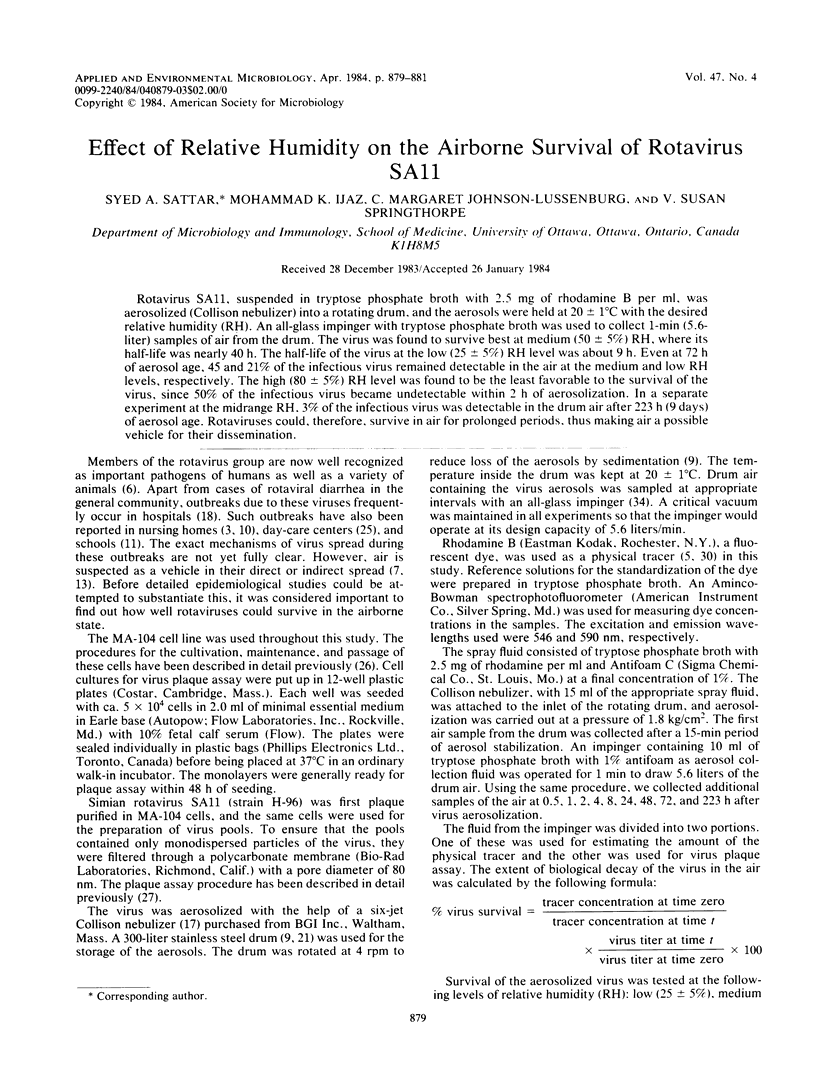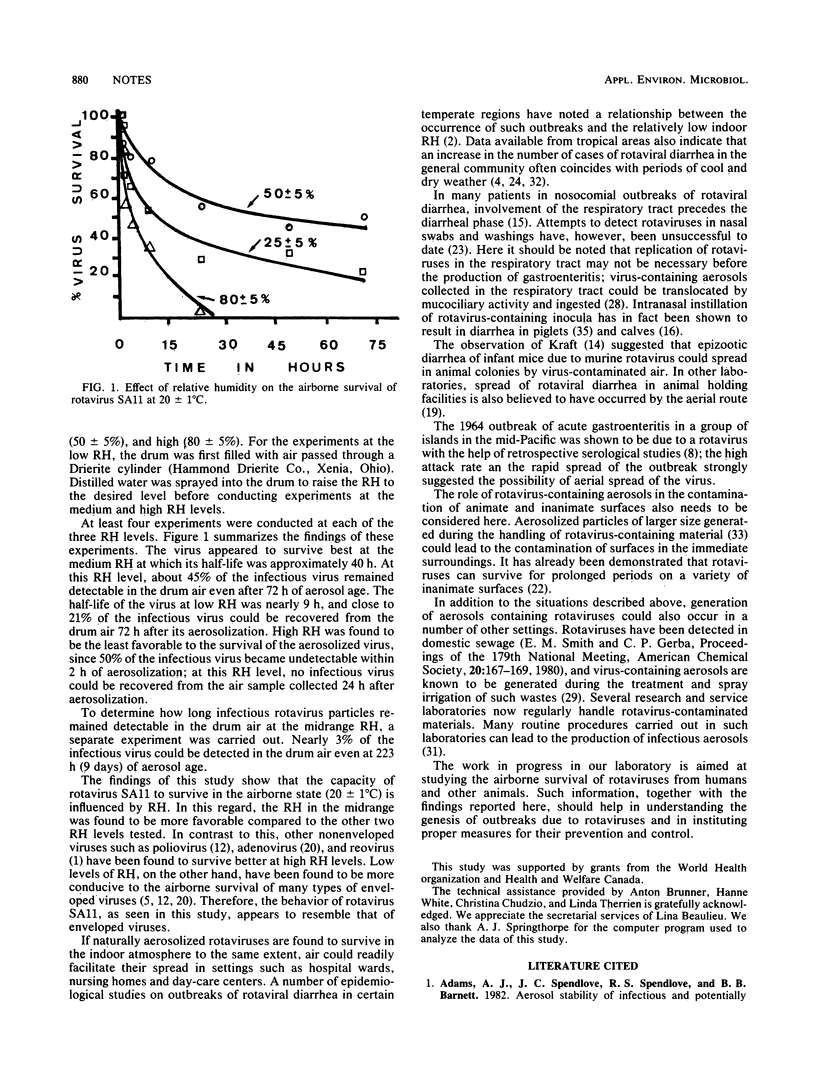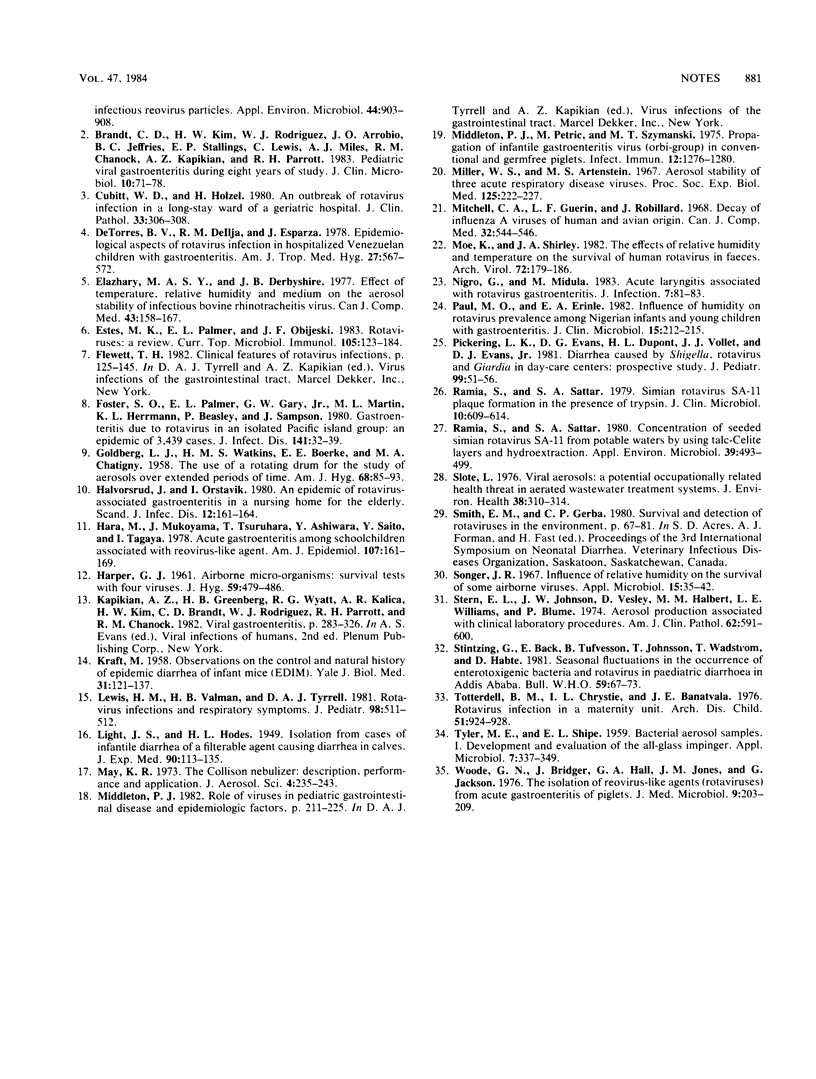Abstract
Rotavirus SA11, suspended in tryptose phosphate broth with 2.5 mg of rhodamine B per ml, was aerosolized (Collison nebulizer) into a rotating drum, and the aerosols were held at 20 +/- 1 degree C with the desired relative humidity (RH). An all-glass impinger with tryptose phosphate broth was used to collect 1-min (5.6-liter) samples of air from the drum. The virus was found to survive best at medium (50 +/- 5%) RH, where its half-life was nearly 40 h. The half-life of the virus at the low (25 +/- 5%) RH level was about 9 h. Even at 72 h of aerosol age, 45 and 21% of the infectious virus remained detectable in the air at the medium and low RH levels, respectively. The high (80 +/- 5%) RH level was found to be the least favorable to the survival of the virus, since 50% of the infectious virus became undetectable within 2 h of aerosolization. In a separate experiment at the midrange RH, 3% of the infectious virus was detectable in the drum air after 223 h (9 days) of aerosol age. Rotaviruses could, therefore, survive in air for prolonged periods, thus making air a possible vehicle for their dissemination.
Full text
PDF


Selected References
These references are in PubMed. This may not be the complete list of references from this article.
- Brandt C. D., Kim H. W., Rodriguez W. J., Arrobio J. O., Jeffries B. C., Stallings E. P., Lewis C., Miles A. J., Chanock R. M., Kapikian A. Z. Pediatric viral gastroenteritis during eight years of study. J Clin Microbiol. 1983 Jul;18(1):71–78. doi: 10.1128/jcm.18.1.71-78.1983. [DOI] [PMC free article] [PubMed] [Google Scholar]
- Cubitt W. D., Holzel H. An outbreak of rotavirus infection in a long-stay ward of a geriatric hospital. J Clin Pathol. 1980 Mar;33(3):306–308. doi: 10.1136/jcp.33.3.306. [DOI] [PMC free article] [PubMed] [Google Scholar]
- Elazhary M. A., Derbyshire J. B. Effect of temperature, relative humidity and medium on the aerosol stability of infectious bovine rhinotracheitis virus. Can J Comp Med. 1979 Apr;43(2):158–167. [PMC free article] [PubMed] [Google Scholar]
- Estes M. K., Palmer E. L., Obijeski J. F. Rotaviruses: a review. Curr Top Microbiol Immunol. 1983;105:123–184. doi: 10.1007/978-3-642-69159-1_3. [DOI] [PubMed] [Google Scholar]
- Foster S. O., Palmer E. L., Gary G. W., Jr, Martin M. L., Herrmann K. L., Beasley P., Sampson J. Gastroenteritis due to rotavirus in an isolated Pacific island group: an epidemic of 3,439 cases. J Infect Dis. 1980 Jan;141(1):32–39. doi: 10.1093/infdis/141.1.32. [DOI] [PubMed] [Google Scholar]
- GOLDBERG L. J., WATKINS H. M., BOERKE E. E., CHATIGNY M. A. The use of a rotating drum for the study of aerosols over extended periods of time. Am J Hyg. 1958 Jul;68(1):85–93. doi: 10.1093/oxfordjournals.aje.a119954. [DOI] [PubMed] [Google Scholar]
- HARPER G. J. Airborne micro-organisms: survival tests with four viruses. J Hyg (Lond) 1961 Dec;59:479–486. doi: 10.1017/s0022172400039176. [DOI] [PMC free article] [PubMed] [Google Scholar]
- Halvorsrud J., Orstavik I. An epidemic of rotavirus-associated gastroenteritis in a nursing home for the elderly. Scand J Infect Dis. 1980;12(3):161–164. doi: 10.3109/inf.1980.12.issue-3.01. [DOI] [PubMed] [Google Scholar]
- Hara M., Mukoyama J., Tsuruhara T., Ashiwara Y., Saito Y., Tagaya I. Acute gastroenteritis among schoolchildren associated with reovirus-like agent. Am J Epidemiol. 1978 Feb;107(2):161–169. doi: 10.1093/oxfordjournals.aje.a112518. [DOI] [PubMed] [Google Scholar]
- KRAFT L. M. Observations on the control and natural history of epidemic diarrhea of infant mice (EDIM). Yale J Biol Med. 1958 Dec;31(3):121–137. [PMC free article] [PubMed] [Google Scholar]
- Lewis H. M., Valman H. B., Tyrrell D. A. Rotavirus infection and respiratory symptoms. J Pediatr. 1981 Mar;98(3):511–512. doi: 10.1016/s0022-3476(81)80750-0. [DOI] [PubMed] [Google Scholar]
- Middleton P. J., Petric M., Szymanski M. T. Propagation of infantile gastroenteritis virus (orbi-group) in conventional and germfree piglets. Infect Immun. 1975 Dec;12(6):1276–1280. doi: 10.1128/iai.12.6.1276-1280.1975. [DOI] [PMC free article] [PubMed] [Google Scholar]
- Miller W. S., Artenstein M. S. Aerosol stability of three acute respiratory disease viruses. Proc Soc Exp Biol Med. 1967 May;125(1):222–227. doi: 10.3181/00379727-125-32054. [DOI] [PubMed] [Google Scholar]
- Mitchell C. A., Guerin L. F., Robillard J. Decay of influenza A viruses of human and avian origin. Can J Comp Med. 1968 Oct;32(4):544–546. [PMC free article] [PubMed] [Google Scholar]
- Moe K., Shirley J. A. The effects of relative humidity and temperature on the survival of human rotavirus in faeces. Arch Virol. 1982;72(3):179–186. doi: 10.1007/BF01348963. [DOI] [PubMed] [Google Scholar]
- Nigro G., Midulla M. Acute laryngitis associated with rotavirus gastroenteritis. J Infect. 1983 Jul;7(1):81–82. doi: 10.1016/s0163-4453(83)91359-2. [DOI] [PubMed] [Google Scholar]
- Paul M. O., Erinle E. A. Influence of humidity on rotavirus prevalence among Nigerian infants and young children with gastroenteritis. J Clin Microbiol. 1982 Feb;15(2):212–215. doi: 10.1128/jcm.15.2.212-215.1982. [DOI] [PMC free article] [PubMed] [Google Scholar]
- Pickering L. K., Evans D. G., DuPont H. L., Vollet J. J., 3rd, Evans D. J., Jr Diarrhea caused by Shigella, rotavirus, and Giardia in day-care centers: prospective study. J Pediatr. 1981 Jul;99(1):51–56. doi: 10.1016/s0022-3476(81)80956-0. [DOI] [PubMed] [Google Scholar]
- Ramia S., Sattar S. A. Concentration of seeded simian rotavirus SA-11 from potable waters by using talc-celite layers and hydroextraction. Appl Environ Microbiol. 1980 Mar;39(3):493–499. doi: 10.1128/aem.39.3.493-499.1980. [DOI] [PMC free article] [PubMed] [Google Scholar]
- Ramia S., Sattar S. A. Simian rotavirus SA-11 plaque formation in the presence of trypsin. J Clin Microbiol. 1979 Nov;10(5):609–614. doi: 10.1128/jcm.10.5.609-614.1979. [DOI] [PMC free article] [PubMed] [Google Scholar]
- Slote L. Viral aerosols--A potential occupationally related health threat in aerated wastewater treatment systems. J Environ Health. 1976 Mar-Apr;38(5):310–314. [PubMed] [Google Scholar]
- Songer J. R. Influence of relative humidity on the survival of some airborne viruses. Appl Microbiol. 1967 Jan;15(1):35–42. doi: 10.1128/am.15.1.35-42.1967. [DOI] [PMC free article] [PubMed] [Google Scholar]
- Stern E. L., Johnson J. W., Vesley D., Halbert M. M., Lawrence B. S., Williams L. E., Blume P. Aerosol production associated with clinical laboratory procedures. Am J Clin Pathol. 1974 Nov;62(5):591–600. doi: 10.1093/ajcp/62.5.591. [DOI] [PubMed] [Google Scholar]
- Stintzing G., Bäck E., Tufvesson B., Johnsson T., Wadström T., Habte D. Seasonal fluctuations in the occurrence of enterotoxigenic bacteria and rotavirus in paediatric diarrhoea in Addis Ababa. Bull World Health Organ. 1981;59(1):67–73. [PMC free article] [PubMed] [Google Scholar]
- TYLER M. E., SHIPE E. L. Bacterial aerosol samplers. I. Development and evaluation of the all-glass impinger. Appl Microbiol. 1959 Nov;7:337–349. doi: 10.1128/am.7.6.337-349.1959. [DOI] [PMC free article] [PubMed] [Google Scholar]
- Torres B. V., Ilja R. M., Esparaza J. Epidemiological aspects of rotavirus infection in hospitalized Venezuelan children with gastroenteritis. Am J Trop Med Hyg. 1978 May;27(3):567–572. doi: 10.4269/ajtmh.1978.27.567. [DOI] [PubMed] [Google Scholar]
- Totterdell B. M., Chrystie I. L., Banatvala J. E. Rotavirus infections in a maternity unit. Arch Dis Child. 1976 Dec;51(12):924–928. doi: 10.1136/adc.51.12.924. [DOI] [PMC free article] [PubMed] [Google Scholar]
- Woode G. N., Bridger J., Hall G. A., Jones J. M., Jackson G. The isolation of reovirus-like agents (rota-viruses) from acute gastroenteritis of piglets. J Med Microbiol. 1976 May;9(2):203–209. doi: 10.1099/00222615-9-2-203. [DOI] [PubMed] [Google Scholar]


